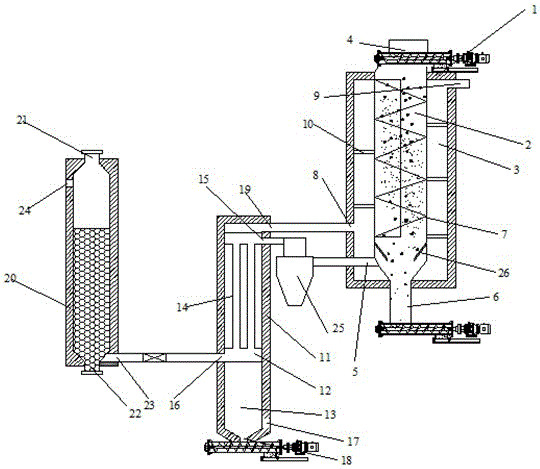A method for producing hydrogen by blending gasification of sludge and biomass
A blending and gasification chamber technology, applied in chemical instruments and methods, hydrogen, inorganic chemistry, etc., can solve the problems of sludge fertilizer food safety risks, poor catalytic cracking effect, hidden safety hazards, etc., and achieve high energy utilization efficiency. , reduce catalyst carbon deposition, easy to control the effect of precise
- Summary
- Abstract
- Description
- Claims
- Application Information
AI Technical Summary
Problems solved by technology
Method used
Image
Examples
Embodiment 1
[0027] Such as figure 1 As shown, the device of the present invention using sludge and biomass blended gasification to produce hydrogen is an externally heated sludge and biomass blended gasification-tar cracking-catalytic reforming ternary composite hydrogen production The device includes a gasification furnace, a high-temperature cracking furnace and a catalytic reforming furnace, respectively performing sludge and biomass gasification, tar gas high-temperature cracking and catalytic reforming.
[0028] The gasification furnace 1 includes a gasification chamber 2 and an external heating chamber 3. The top of the gasification chamber 2 is provided with a blended particle feeder 4, and the bottom is provided with a gasification tar gas outlet 5 and a gasification ash outlet 6. The gasification chamber 2 There are spiral guide vanes 7 inside; the bottom of the outer heating chamber 3 is equipped with a high-temperature flue gas inlet 8, and the upper part is equipped with a hig...
Embodiment 2
[0041] The method for producing hydrogen by blending gasification of sludge and biomass described in this example is as follows:
[0042] (1) Municipal sludge is dehydrated, and after dehydration, no drying treatment is required to blend with crushed organic waste particles to form particles for gasification; Water content of the blend: the ratio of carbon content = 1.2 is mixed evenly, and gasification is carried out at 900 ° C; the diameter of the particles is between 4-10 mm;
[0043] (2) Before the catalytic reforming, the tar gas produced by blending gasification first enters the pyrolysis furnace for thermal cracking, and after cracking at 1000°C for 20 seconds, most of the tar is fully decomposed at this stage;
[0044] (3) In the pyrolysis stage, the undecomposed tar gas and water vapor enter the catalytic furnace for catalytic decomposition, using olivine particles as catalysts, and the low molecular hydrocarbons are reformed and transformed into H 2 and CO.
[0045...
Embodiment 3
[0048] The method for producing hydrogen by blending gasification of sludge and biomass described in this example is as follows:
[0049] (1) Dewatering the municipal sludge, after dehydration, it does not need to be dried and blended with plastic granules to make granules for gasification; the mixing ratio of the granules is to dehydrate the dehydrated municipal sludge and plastic granules according to the water content of the blend : The ratio of carbon content = 1.5 is mixed evenly, and gasification is carried out at 950 ° C; the diameter of the particles is between 4-10mm;
[0050] (2) Before the catalytic reforming, the tar gas produced by blending gasification first enters the high-temperature cracking furnace for thermal cracking, and after cracking at 1100°C for 10 seconds, most of the tar is fully decomposed at this stage;
[0051] (3) The undecomposed tar gas and water vapor in the high-temperature cracking stage enter the catalytic furnace for catalytic decompositio...
PUM
| Property | Measurement | Unit |
|---|---|---|
| diameter | aaaaa | aaaaa |
Abstract
Description
Claims
Application Information
 Login to View More
Login to View More - R&D
- Intellectual Property
- Life Sciences
- Materials
- Tech Scout
- Unparalleled Data Quality
- Higher Quality Content
- 60% Fewer Hallucinations
Browse by: Latest US Patents, China's latest patents, Technical Efficacy Thesaurus, Application Domain, Technology Topic, Popular Technical Reports.
© 2025 PatSnap. All rights reserved.Legal|Privacy policy|Modern Slavery Act Transparency Statement|Sitemap|About US| Contact US: help@patsnap.com


